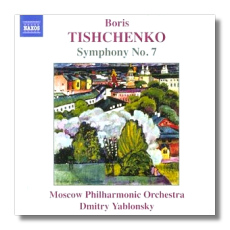
The Internet's Premier Classical Music Source
Related Links
- Latest Reviews
- More Reviews
-
By Composer
-
Collections
DVD & Blu-ray
Books
Concert Reviews
Articles/Interviews
Software
Audio
Search Amazon
Recommended Links
Site News
 CD Review
CD Review
Tishchenko / Isasi

Boris Tishchenko
- Symphony #7, Op. 119
Moscow Philharmonic Orchestra/Dmitry Yablonsky
Live Recording: Grand Hall of the Moscow Conservatory - Feb. 26, 2002
Naxos 8.557013


Andrés Isasi
- Symphony #2 in G minor, Op. 23
- Suite #2 in E Major, Op. 21
Bilbao Symphony Orchestra/Juan José Mena
Naxos 8.557584
Two little-known composers appear on this pair of recent issues on the Naxos label. Leningrad-born Boris Tishchenko (b. 1939) has achieved a measure of fame and is still alive. The Spanish composer Andrés Isasi (1890-1940) was born in Bilbao but studied in Berlin, his teachers including Engelbert Humperdinck. His music, at least what is presented on this CD, sounds more German than Spanish. But it the Russian Tishchenko who is the more interesting figure here, at least if I can judge from his Symphony #7.
Tishchenko clearly divulges the influence of Shostakovich throughout the work, especially in the last four of the work's five movements. The first movement starts with muted trumpets echoing music that recalls the opening of Shostakovich's Eleventh Symphony. There follows a jovial theme given by the clarinet over bouncy pizzicato strings, and soon a somber, ponderous motif is played by the strings. These various elements alternate before the music intensifies and eventually erupts in angry outbursts, with very active percussion. There is much dark humor and grotesquerie in this movement, and much in the ensuing movement as well. Here the main theme sounds like a variant of its counterpart in Debussy's Golliwog's Cakewalk. When the piano and xylophone enter the mood turns to pure rollicking slapstick, but, as in the first movement, the music turns intense and then begins to grow more unruly by the measure. Again the timpani play a large role in the utterly shattering climactic passages that follow.
The third movement features a haunting, obsessive theme, played by oboe and later taken up by strings. The mood is dark and meditative throughout. In the fourth movement, things brighten a bit with an elegant, somewhat wistful theme for strings, but the feeling of loneliness pervades the music, even during the slightly comical passage for brass and woodwind at the center of the movement. The finale begins with a joyous theme for piccolo and strings, tinged with Spanish flavors. When the bassoon takes up the theme, one cannot help but hear the voice of Shostakovich everywhere. Again, the music darkens in the interior portions and though the main theme returns, it does not dispel the shadows that have crept in. The symphony ends with a brash, garish restatement of the main theme, in what comes across as mock triumph. Yablonsky and his Moscow players turn in a splendid performance and the sound is vivid.
The Isasi Symphony #2 is less adventurous and more anonymous-sounding in character. Not that its music isn't well-crafted and charming: indeed, it features several attractive themes and gorgeous orchestration. Elgar and Richard Strauss come to mind here, and those listeners seeking a work infused with a rich post-Romantic soul will undoubtedly find this to their liking. The first movement is beautiful and thematically the most appealing, while the third movement Scherzo is probably the most colorful of the four panels. But the finale has some interesting features, too: Isasi uses a theme that Naxos annotator Richard Whitehouse describes as having a "Russian liturgical cast." It has a liturgical feel to it, but I'm not sure it's particularly Russian. In any event, it is quite catchy and the whole movement radiates a sense of joy and triumph. The Suite #2 is a colorful three-movement work lasting nearly twelve minutes, and makes a nice bonus here. The performances by the Bilbao Symphony Orchestra are quite impressive under Mena's insightful direction. Again, the sound and notes are excellent.
Copyright © 2004, Robert Cummings



















